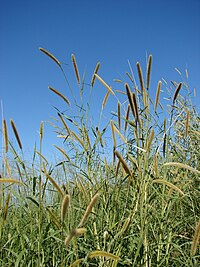
Photo from wikipedia
Adnew W, Tsegay BA, Tassew A, Asmare B. 2018. Assessments of farmers′ perception and utilization status of Brachiaria grass in selected areas of Ethiopia. Biodiversitas 19: 955-966. The study was… Click to show full abstract
Adnew W, Tsegay BA, Tassew A, Asmare B. 2018. Assessments of farmers′ perception and utilization status of Brachiaria grass in selected areas of Ethiopia. Biodiversitas 19: 955-966. The study was conducted to evaluate farmers′ perception and utilization status of Brachiaria grass in selected areas of Ethiopia. It was done between April and June 2017. The study employed a multistage sampling method based on the level of distribution of Brachiaria grass as push-pull technology and animal feeds. Respondent farmers were selected purposely based on their practice of Brachiaria grass production and use. A total of 280 household heads, 160 from Oromiya and 120 from Amhara regions, proportionally selected were interviewed. The average land holding per household was 1.79±1.73 hectares and average household size was 6.60±1.99 persons. Identified constraints of forage production were ranked as land shortage (1st), free grazing (2nd), lack and high cost of planting materials (3rd), poor extension service (4th), drought (5th), and lack of awareness (6th). Of the problems, the finding indicated that feed shortage during long dry season (77.0%) is a critical problem. From total respondents, 96.1% faced feed shortage for their livestock at least once a year. Major constraints to improve forage production were ranked as land shortage, unmanaged grazing, lack of grass planting materials, poor extension service and drought, orderly. All respondents (100%) from Oromiya and 52.1% of respondents from Amhara have got training about use of Brachiaria grass. Majority of the respondents (97.3%) believed that Brachiaria grass is much productive compared to other grasses. Overall, the study showed that training to farmers and adequate provision of extension services on the use of Brachiaria grass are necessary to exploit the potential of the grass in the study districts as well as the country at large.
Journal Title: Biodiversitas
Year Published: 2018
Link to full text (if available)
Share on Social Media: Sign Up to like & get
recommendations!